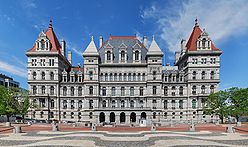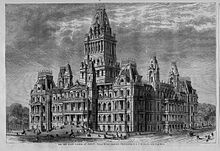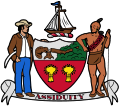- New York State Capitol
-
New York State Capitol 
The New York State Capitol viewed from the southwestGeneral information Architectural style Romanesque Revival architecture and Neo-Renaissance Town or city Albany, New York Country United States Construction started 1867 Completed 1899 Cost $25 million Design and construction Client New York Architect Thomas Fuller
Leopold Eidlitz
Henry Hobson Richardson
Isaac G. PerryNew York State CapitolLocation: Albany, New York Built: 1868 NRHP Reference#: 71000519 Significant dates Added to NRHP: February 18, 1971[1] Designated NHL: January 29, 1979 [2] The New York State Capitol is the capitol building of the U.S. state of New York. Housing the New York State Legislature, it is located in the state capital city Albany, on State Street in Capitol Park. The building, completed in 1899 at a cost of $25 million (worth approximately half a billion current dollars), was the most expensive government building of its time. It was declared a National Historic Landmark in 1979.[2][3]
Contents
History
The current building is the third capitol building. A small building, the Van Gaasbeek house, was used briefly at Kingston, New York.[4] From August 22 to 25, 1777, the Van Schaick House at Cohoes was used by Governor George Clinton as the New York State Capitol.[5] After the Revolution, a second building was erected on land just in front of the current building.
 Interim plan for the Capitol by Thomas Fuller
Interim plan for the Capitol by Thomas Fuller
The present Capitol was constructed between 1867 and 1899. Three teams of architects worked on the design of the Capitol during the 32 years of its construction. They were managed by: 1867-75: Thomas Fuller, 1875-83: Leopold Eidlitz and Henry Hobson Richardson, 1883-99: Isaac G. Perry. Fuller, the initial architect, was an Englishman who also designed the Canadian Parliament buildings in Ottawa.
The ground floor of the state capitol was built in the Classical/Romanesque style. Lieutenant Governor William Dorsheimer then dismissed Fuller in favor of Eidlitz and Richardson.[6], who built the next two floors in a Renaissance Classical style, noticeable on the exterior two floors as light, open columnwork. The increasing construction costs became an ongoing source of conflict in the legislature, and it was difficult to secure the funding necessary. Eidlitz and Richardson, were dismissed by Grover Cleveland upon his election to governorship and his review of the increasing costs of construction. He hired Perry to complete the project.[6] The legislative chambers, the fourth floor and roof work were all finished in Victorian-modified Romanesque that was distinctively Richardson's design. It "was Richardson who dominated the final outcome of the grand building, which evolved into his distinguished Romanesque style" (which came to be known as Richardsonian Romanesque).[6] It is claimed that Richardson was imitating the Hôtel de Ville (City Hall) in Paris, France.
The central open court is dominated by a shaft intended to support a massive dome. The dome and tower were never completed, as it was found that the weight of the building was already causing stress fractures and actually to make the build shift downhill toward State Street. To stop this movement, a very large, 166-foot (51 m) long exterior Eastern Staircase was added to support the front facade. The Capitol exterior is made of white granite from Hallowell, Maine, and the building incorporates marble cut by state prisoners at Sing Sing. The granite structure is 220 feet (67 m) tall at its highest point, and it is one of ten U.S. state capitols that does not have a domed roof. Underground tunnels connect it to the Empire State Plaza and Alfred E. Smith Building. The building's exterior is currently undergoing restoration.[7]
The Assembly Chamber was built originally with the largest open arched span in the world. However, this produced very inconvenient acoustic results. A more serious problem was that the shifting foundations of the whole structure made the vaults unstable. A lower false ceiling was introduced to prevent rock shards from the vaults from falling to the assembly floor.[8]
The Capitol initially featured two large murals by Boston artist William Morris Hunt painted directly onto the sandstone walls of the Assembly Chamber. The two enormous works, named The Flight of Night and The Discoverer, each some 45-feet long, were later covered when the Assembly's vaulted ceiling proved unstable and the ceiling was lowered four feet below the murals. Earlier, the murals had been damaged by moisture in the building and had begun to flake. Plans for later murals by Hunt were abandoned due to lack of funding, and some people have speculated the artist's suicide might have resulted from his resulting depression.[9][10][11]
Reputed ghosts
There have been reports that the building is haunted, to the point that a local historian offers a special Hauntings Tour. The best-known ghost is alleged to be that of Samuel Abbott, a night watchman who died during a severe fire in 1911, a fire that also destroyed half a million books while sparing sacred Iroquois artifacts. A ghost haunting the Assembly chamber, supposedly producing cold spots and occasional flickering lights, is believed to be William Morris Hunt, angry over his work being concealed. Another one is said to be a local fruit vendor, despondent over his business, who committed suicide in 1890 by jumping off the staircase to the Senate chamber on the fourth floor.[12]
Gallery
-
Panorama of the New York State Assembly Chamber
-
A statue of George Washington behind the Capitol
-
Study for Fortune, a figure in the now-obscured William Morris Hunt murals
See also
- List of National Historic Landmarks in New York
- List of reportedly haunted locations in the United States
- National Register of Historic Places listings in Albany, New York
References
- ^ "National Register Information System". National Register of Historic Places. National Park Service. 2007-01-23. http://nrhp.focus.nps.gov/natreg/docs/All_Data.html.
- ^ a b "New York State Capitol". National Historic Landmark summary listing. National Park Service. http://tps.cr.nps.gov/nhl/detail.cfm?ResourceId=1120&ResourceType=Building. Retrieved 2007-09-11.
- ^ Carolyn Pitts (January 1979). http://pdfhost.focus.nps.gov/docs/NHLS/Text/71000519.pdf National Register of Historic Places Inventory-Nomination: New York State Capitol]PDF (437 KiB). National Park Service. and http://pdfhost.focus.nps.gov/docs/NHLS/Photos/71000519.pdf Accompanying 1 photo, exterior, undated.]PDF (289 KiB)
- ^ http://www.revolutionaryday.com/usroute9w/kingston/default.htm
- ^ Chester H. Liebs (July 1970). "National Register of Historic Places Registration:Van Schaick House". New York State Office of Parks, Recreation and Historic Preservation. http://www.oprhp.state.ny.us/hpimaging/hp_view.asp?GroupView=509. Retrieved 2010-10-13.
- ^ a b c Historic New York: Architectural Journeys in the Empire State - Chapter 8, Finger Lakes
- ^ http://www.ogs.state.ny.us/aboutOgs/pressReleases/2008/OGSCapitolCommission.htm
- ^ http://www.jgwaarchitects.com/portfolio/public-buildings/nys-assembly/nys-assembly.html
- ^ Hunting Ghosts and History at the New York State Capitol, 27 October 2009, Timesunion.com
- ^ The Horses of Anahita or The Flight of Night, The Metropolitan Museum of Art
- ^ Art-Life of William Morris Hunt, Helen M. Knowlton, Reprinted by READ country books
- ^ Leyden, Liz (October 27, 2011). "Spending a Night With Ghosts Where Legislators Roam". The New York Times. http://www.nytimes.com/2011/10/27/nyregion/at-capitol-in-albany-spending-an-evening-with-ghosts.html. Retrieved October 28, 2011.
- New York State Capitol at Emporis Buildings
External links
- New York State Capitol Virtual Tour
- New York State Capitol at Wonders of the World Databank
- Visiting the New York State Capitol
- New York State Capitol History and Timeline
- New York State Capitol: 2 photos at Historic American Building Survey
- New York State Capitol sample page from a coffee-table book
- New York State Capitol: 30 photos
Coordinates: 42°39′09″N 73°45′26″W / 42.652553°N 73.757323°W
State Capitols of the United States Alabama · Alaska · Arizona · Arkansas · California · Colorado · Connecticut · Delaware · Florida · Georgia · Hawaii · Idaho · Illinois · Indiana · Iowa · Kansas · Kentucky · Louisiana · Maine · Maryland · Massachusetts · Michigan · Minnesota · Mississippi · Missouri · Montana · Nebraska · Nevada · New Hampshire · New Jersey · New Mexico · New York · North Carolina · North Dakota · Ohio · Oklahoma · Oregon · Pennsylvania · Rhode Island · South Carolina · South Dakota · Tennessee · Texas · Utah · Vermont · Virginia · Washington · West Virginia · Wisconsin · Wyoming
District of Columbia · Puerto Rico
Territorial CapitolsHistory GeneralHistory (Prehistory–1664, 1664–1784, 1784–1860, 1860–1900, 1900–1942, 1942–1983, 1983–present) · Architecture · National Register of Historic Places listings17th centuryMohawks · Mahicans · Dutch West India Company (1621–1791) · Fort Nassau (1614) · Fort Orange (1624) · Rensselaerswijck (1629–1840) · Beverwijck (1652–1664) · Stadt Huys (1635, 1646, or 1673) · Fort Frederick (1676–1789) · Dongan Charter (1686)18th centuryVan Ostrande-Radliff House (1728) · Quackenbush House (1736) · Albany Plan of Union (1754) · Schuyler Mansion (1765)19th centuryClermont (1807) · Erie Canal (1825) · Albany Basin (1825) · Albany Lumber District (1830s–1908) · City Hall (1832) · Governor's Mansion (1856) · City Hall (1883) · New York State Capitol (1899)20th centuryAlbany Municipal Airport (1908) · Miss Albany Diner (1941) · W. Averell Harriman State Office Building Campus (1956–1994) · Albany County Airport (1960) · Empire State Plaza (1965–1978) · Times Union Center (1990) · Albany International Airport (1996–1998)21st centuryHudson River Way (2002) · Albany Convention Center (proposed)
Government Mayor of Albany (current: Gerald Jennings) · Albany City Hall · Coat of arms · See also: Government of New YorkNeighborhoods Arbor Hill · Buckingham Pond · Center Square · Delaware Avenue · Dudley Heights · Dunes · Eagle Hill · Helderberg · Hudson-Park · Melrose · New Albany · Normansville · North Albany · Park South · Pine Hills · Sheridan Hollow · South End (Kenwood · Krank Park · Mansion District · Mount Hope · The Pastures · Second Avenue) · University Heights · Washington Park · West Hill · WhitehallPeople Thomas Dongan (1634–1715) · Peter Schuyler (1657–1724) · Erastus Corning (1794–1872) · Daniel P. O'Connell (1885–1977) · Erastus Corning 2nd (1909–1983) · John McEneny (1943–present)Geography LandAlbany Pine Bush · Westerlo IslandWaterBuckingham Lake · Hudson River (Valley) · Normans Kill · Patroon Creek · Rensselaer Lake · Tivoli Lake · Washington Park LakeEducation SecondaryAcademy of the Holy Names · The Albany Academy · Albany Academy for Girls · Albany Free School · Bishop Maginn High School · City School District of Albany (Albany High School) · LaSalle School · See also: List of school districts in New York's Capital DistrictHigherAlbany College of Pharmacy and Health Sciences · Albany Law School · Albany Medical College · College of Saint Rose · Excelsior College · Maria College · Mildred Elley · Sage College of Albany · SUNY Albany · See also: List of colleges and universities in New York's Capital DistrictReligion Episcopal Diocese of Albany (Cathedral of All Saints · Bishop William Love) · Roman Catholic Diocese of Albany (Cathedral of the Immaculate Conception · Bishop Howard Hubbard)Culture Culture in New York's Capital District · Sports in New York's Capital DistrictTransportation Adirondack Northway · Albany-Rensselaer Rail Station · Albany International Airport · CDTA · Interstate 87 · Interstate 90 · Interstate 787 · New York State Thruway · Port of Albany–Rensselaer · Streets of Albany, New YorkU.S. National Register of Historic Places in New York Lists by county Albany • Allegany • Bronx • Broome • Cattaraugus • Cayuga • Chautauqua • Chemung • Chenango • Clinton • Columbia • Cortland • Delaware • Dutchess • Erie • Essex • Franklin • Fulton • Genesee • Greene • Hamilton • Herkimer • Jefferson • Kings (Brooklyn) • Lewis • Livingston • Madison • Monroe • Montgomery • Nassau • New York (Manhattan) • Niagara • Oneida • Onondaga • Ontario • Orange • Orleans • Oswego • Otsego • Putnam • Queens • Rensselaer • Richmond (Staten Island) • Rockland • Saratoga • Schenectady • Schoharie • Schuyler • Seneca • St. Lawrence • Steuben • Suffolk • Sullivan • Tioga • Tompkins • Ulster • Warren • Washington • Wayne • Westchester • Wyoming • Yates

Lists by city Albany • Buffalo • New Rochelle • New York City (Bronx · Brooklyn · Queens · Staten Island · Manhattan: Below 14th St. · 14th–59th St. · 59th–110th St. · Above 110th St. · Minor islands) • Peekskill • Poughkeepsie • Rhinebeck • Rochester • Syracuse • YonkersOther lists Categories:- Buildings with sculpture by Corrado Parducci
- Empire State Plaza
- Government buildings on the National Register of Historic Places in New York
- Government of New York
- H. H. Richardson buildings
- History museums in New York
- Leopold Eidlitz buildings
- Museums in Albany, New York
- National Historic Landmarks in New York
- Reportedly haunted locations in the United States
- Romanesque Revival architecture in New York
- State capitols in the United States
Wikimedia Foundation. 2010.







